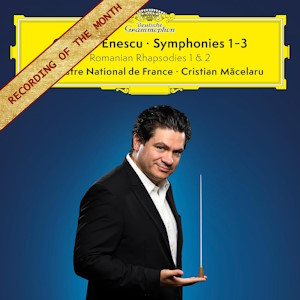
George Enescu (1881-1955)
Romanian Rhapsody, Op.11 No.1 (1901)
Romanian Rhapsody, Op.11 No.2 (1901)
Symphony No.1 in E flat major, Op.13 (1905)
Symphony No.2 in A major, Op.17 (1912-14)
Symphony No.3 in C major, Op.21 (1916-18)
Orchestre National de France/Cristian Măcelaru
rec. 2022/23, Auditorium de Radio France, Paris
Deutsche Grammophon 4865505 [3 CDs: 162]
Yehudi Menuhin described him as “the Absolute by which I judge all others………the most extraordinary human being, the greatest musician and the most formative influence I have ever experienced”. For Pablo Casals he was “the greatest musical phenomenon since Mozart”. George Enescu certainly brought the midas touch to everything musical he turned his hand to, whether it be as violinist, pianist, conductor or composer. Born in Romania he later settled and made his home in Paris. It’s very fitting that the conductor on this recent release is the Romanian Cristian Măcelaru, directing the Paris-based Orchestre National de France. Here they present the composer’s three published symphonies (two others were left unfinished at the time of his death). In addition, we have the two delightful Romanian Rhapsodies, his best known works, youthful compositions from his teenage years.
The 24 year old Enescu completed his First Symphony in 1905 and it was premiered a year later in Paris, bearing a dedication to Alfred Casella. It’s a late-romantic construction cast in three movements, and whilst it is the shortest of the composer’s symphonies, it embodies a wealth of imaginative ideas. It opens heroically, striding forth with a determined and strong sense of purpose. It’s not all triumph and confidence, however. The music eventually settles into a more lyrical section with echoes of Brahms. Towards the end, the self-assured mood returns. Whereas the influences of Brahms and Wagner may be detected in the first movement, the second movement, marked Lent, is more framed in the language of Franck and D’Indy. It’s an exquisitely painted lyrical canvas overflowing with rich flowing melody. The finale, Vif et vigoureux, reminds me very much of Richard Strauss, with its richly embroidered orchestration and intrepid gestures. Măcelaru adopts ideal tempi throughout and pays meticulous attention to pointing up orchestral detail.
Considered a masterpiece by Yehudi Menuhin, he conducted a performance of it towards the end of his life, the Symphony No. 2 is the longest of the three. Enescu penned it just before the start of World War 1, and he himself premiered it with the Orchestra of the Ministry of Public Education at the Athenaeum in Bucharest on 15 March 1915. The work is in four movements, the last two being linked. The first movement opens with Straussian exuberance and brash, flamboyant rodomontade. Interspersed throughout are sections of sensuous sojourn. All is cloaked in colourful orchestration. A solo horn ushers in the slow movement. It has a leisurely, even languorous feel to it. Yet, it traverses along with sumptuous radiance. Măcelaru shapes and contours the phrases with a real love and affection for the music. A sense of portent informs the brief martial third movement, and this leads into a spirited finale. Echoes of Richard Strauss are not far away. It all concludes in a feast of impressive musical ingenuity.
Between 1916 and 1918, Enescu was occupied with his three movement Third Symphony. He later revised it several times. He employs a large orchestra and in the final movement a wordless chorus. In the opener, turmoil and strife alternate with more calm, radiant moments. In these, Enescu’s skilful orchestration has some delightful passages of striking luminosity. There follows a will-o’-the-wisp movement of gossamer lightness, at times flurried and daemonic. The finale, marked Lento, begins in a demeanour of hazy lassitude. The chorus enter, Debussian and evocative. Măcelaru negotiates the shifting orchestral colours to perfection.The mood is one of longing and yearning. I must add that the choir are mightily impressive.
George Enescu is best known for his two Romanian Rhapsodies, written in 1901 and first performed together two years later. They explore the colourful folk music of his native Romania. No. I is a medley of traditional Romanian folk themes he heard as a child. No. 2 is less famous. Its more serene character has a Dvorákian bent. Măcelaru and his orchestra perform them with true authentic spirit. No. 1 spotlights an array of kaleidoscopic orchestral colours, whereas No. 2 expresses more free-flowing lyricism.
These well-recorded performances will win over many to these captivating scores.
Stephen Greenbank
If you purchase this recording using a link below, it generates revenue for MWI and helps us maintain free access to the site



















